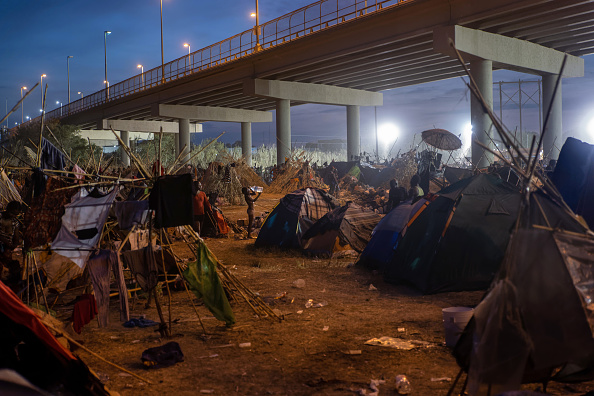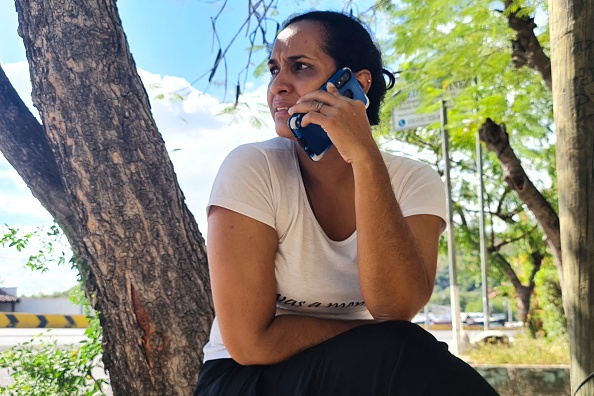
A major issue facing U.S. immigration authorities is how to respond to migratory forces bringing pressure to the country’s borders. But any legislation addressing border management or immigration policy will be, as Ideaspace noted last month, difficult if not impossible to pass in a hyper-polarized 118th Congress.
Such a dynamic brings renewed focus on the actions of the executive branch when it comes to border management. The Biden administration has been active on this front, advancing several policies that address both how migrants are processed and the factors that drive migration.

Within days of moving into the White House, the Biden administration issued Executive Order 14010, which creates a “comprehensive regional framework” to do three things: address the causes of migration, manage migration throughout the Americas, and provide safe and orderly processing for asylum seekers who arrive at U.S. borders. The plan for fulfilling the February 2021 order was released to the public five months later in two separate documents. The first, entitled, Collaborative Migration Management Strategy, outlines the administration’s approach to managing migration at the border, while the second document, entitled U.S. Strategy for Addressing the Root Causes of Migration in Central America, lays out tools for addressing the forces that drive individuals to migrate from Central America.
The first part of the comprehensive framework includes many new policies that deal squarely with managing the flow of migrants arriving at U.S. borders. There are new rules that further penalize migrants who don’t use ports of entry; a provision that insists most migrants first seek asylum in other countries, echoing a similar policy established under the Trump administration; a requirement that most migrants use a government-run app for making an appointment to begin the asylum process; and plans for more regional processing centers at the southern border — with opportunities for some migrants to have their asylum claims heard in a few weeks without being added to the immigration court backlog.
 With the Republican Party acutely focused on border issues, that part of the comprehensive framework has received a lot of attention. What has received far less attention is the second half of the plan, which spells out the administration’s approach to addressing “the root causes of irregular migration” and “collaboratively managing migration in the region.” Rather than reforming border management directly, this part of the framework seeks to get at a more fundamental question: Why do so many people in Central America attempt to immigrate to the U.S., and what can the U.S. do about it?
With the Republican Party acutely focused on border issues, that part of the comprehensive framework has received a lot of attention. What has received far less attention is the second half of the plan, which spells out the administration’s approach to addressing “the root causes of irregular migration” and “collaboratively managing migration in the region.” Rather than reforming border management directly, this part of the framework seeks to get at a more fundamental question: Why do so many people in Central America attempt to immigrate to the U.S., and what can the U.S. do about it?
“When people talk about the humanitarian crisis at the border, clearly it’s a symptom of a more deep, entangled set of conditions in the region where people are coming from,” says Ariel Ruiz Soto, a policy analyst at the Migration Policy Institute. “There’s a regional crisis and the border is one of the consequences of that regional crisis. Trying to solve or address irregular migration at the U.S.-Mexico border is already too late. What we need to do is better manage how migration happens and try to provide alternative legal pathways into the United States. But if we keep thinking of the U.S.-Mexico border as the solution to irregular migration, I think time and time again, we’re going to be disappointed with the results that we achieve.”
So, what is the Biden administration’s approach to identifying and addressing the root causes of migration? What has the administration promised, what has it delivered, and what are the next steps to prioritize?
***
The Biden administration’s Root Causes Strategy is squarely focused on the Northern Triangle countries of Honduras, Guatemala, and El Salvador, which drive much of the migration to the U.S. southern border. The plan, which is being implemented by Vice President Kamala Harris, is organized into five “pillars”: one, addressing economic insecurity and inequality; two, combating corruption, strengthening democratic governance, and advancing the rule of law; three, promoting respect for human rights, labor rights, and a free press; four, countering and preventing violence, extortion, and other organized crimes; and five, combating sexual, gender-based, and domestic violence.
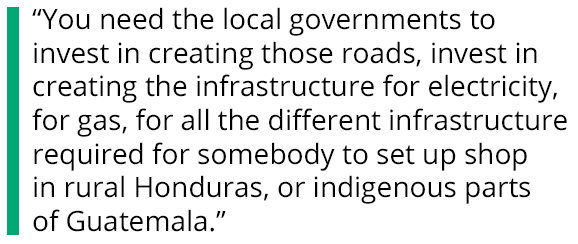 So far, many of Harris’s efforts have focused on the first pillar, which lays out a plan for “fostering the reforms necessary for business to thrive, mobilizing investment, and promoting economic development in the region.” In May 2021, for example, the vice president launched a “Call to Action,” urging U.S. corporations to make financial investments toward doing business in the Northern Triangle. Working with the Partnership for Central America — a non-governmental organization that was set up to coordinate and manage the Call to Action — Vice President Harris quickly secured $1.2 billion in pledges from corporations in the U.S. and throughout Central America. By June of 2021 it was $3.1 billion, and in February of this year the grand total of commitments reached $4.2 billion. Some of the pledges have come from household names like Mastercard and Visa, Nestle and Target; others are lesser-known specialized industry players such as Unifi, which produces synthetic and recycled yarns, and AgroAmerica, a sustainable food and ingredient distribution company.
So far, many of Harris’s efforts have focused on the first pillar, which lays out a plan for “fostering the reforms necessary for business to thrive, mobilizing investment, and promoting economic development in the region.” In May 2021, for example, the vice president launched a “Call to Action,” urging U.S. corporations to make financial investments toward doing business in the Northern Triangle. Working with the Partnership for Central America — a non-governmental organization that was set up to coordinate and manage the Call to Action — Vice President Harris quickly secured $1.2 billion in pledges from corporations in the U.S. and throughout Central America. By June of 2021 it was $3.1 billion, and in February of this year the grand total of commitments reached $4.2 billion. Some of the pledges have come from household names like Mastercard and Visa, Nestle and Target; others are lesser-known specialized industry players such as Unifi, which produces synthetic and recycled yarns, and AgroAmerica, a sustainable food and ingredient distribution company.
While investments from the private sector are the centerpiece of the Call to Action, they are received with an eye toward six identified focus areas for supporting vulnerable populations in the Northern Triangle, mainly women and youth.
“We’ve worked to build a coalition of private sector partners who are focused on committing to changes as we think about rule of law,” says Jonathan Fantini-Porter, Executive Director of the Partnership for Central America, who previously worked at the Department of Homeland Security and as a national security aide in the Obama White House. “You’ve got to have the infrastructure and the enabling environment to support those investments, and job creation.”
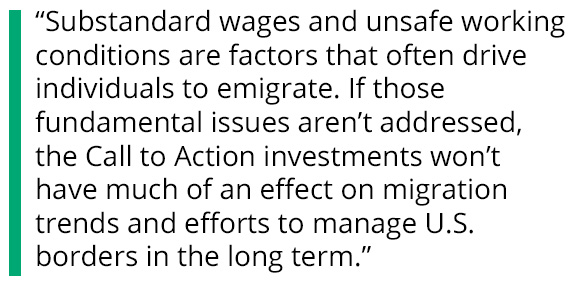 Some investments already come with granular details: Chobani, the yogurt company, is setting up an incubator program in Guatemala, which is designed to help entrepreneurs start their own operations; the coffee maker Nespresso is setting up a pilot crop insurance program designed to help Central American coffee farmers battle the effects of climate change; and Mastercard is putting together a program aimed at bringing small business into a digital banking system.
Some investments already come with granular details: Chobani, the yogurt company, is setting up an incubator program in Guatemala, which is designed to help entrepreneurs start their own operations; the coffee maker Nespresso is setting up a pilot crop insurance program designed to help Central American coffee farmers battle the effects of climate change; and Mastercard is putting together a program aimed at bringing small business into a digital banking system.
Matthew Rooney, who had a long career at the State Department before joining the George W. Bush Institute as a Senior Advisor with a focus on Central America, highlights the tech sector jobs that have been included in the Call to Action.
“That’s valuable and important,” he says. “Those economies are evolving. The populations of those economies are, in many cases, reasonably well-educated and reasonably well-trained. Therefore a wave of new investment in textiles and apparel, for example, may not be a sustainable future job for somebody [in the modern labor market]. So that’s valuable, to look at those kinds of future-leaning sectors and try to open those opportunities.”
To date, the Biden administration has touted commitments from 47 companies across financial services, textiles and apparel, agriculture, telecommunications, technology, and the non-profit sector — all promising to generate tens of thousands of jobs in total. But the quality and location of the newly created jobs are crucial details.
 Experts like Ruiz Soto emphasize the importance of making newly-created jobs accessible to those who need them most. “If, for example, Microsoft wanted to create a factory in Honduras,” he says, “it is not as simple as saying that Microsoft will put in millions of dollars to create a factory. One, it requires that the local workers are trained specifically in these sectors, but two, it requires infrastructure in the places where factories are going to be located. You need the local governments to invest in creating those roads, invest in creating the infrastructure for electricity, for gas, for all the different infrastructure required for somebody to set up shop in rural Honduras, or indigenous parts of Guatemala, for example. What we’ve known is that a significant part of migration is coming from the rural parts of these countries and from indigenous communities.”
Experts like Ruiz Soto emphasize the importance of making newly-created jobs accessible to those who need them most. “If, for example, Microsoft wanted to create a factory in Honduras,” he says, “it is not as simple as saying that Microsoft will put in millions of dollars to create a factory. One, it requires that the local workers are trained specifically in these sectors, but two, it requires infrastructure in the places where factories are going to be located. You need the local governments to invest in creating those roads, invest in creating the infrastructure for electricity, for gas, for all the different infrastructure required for somebody to set up shop in rural Honduras, or indigenous parts of Guatemala, for example. What we’ve known is that a significant part of migration is coming from the rural parts of these countries and from indigenous communities.”
Beyond the question of accessibility, the quality and nature of the promised jobs are also essential. Substandard wages and unsafe working conditions are factors that often drive individuals to emigrate. If those fundamental issues aren’t addressed, the Call to Action investments won’t have much of an effect on migration trends and efforts to manage U.S. borders in the long term. The Biden administration, keenly aware of this, emphasizes the strengthening of labor and human rights as another pillar of the Root Causes Strategy.
Many of the rules for working conditions in Central America are dictated by CAFTA, the Central American Free Trade Agreement, which borrows much of its framework from what was originally known as NAFTA and is now USMCA, the trade agreement among the U.S., Mexico and Canada. “CAFTA has a labor chapter, which is intended as a tool to enable labor unions to organize,” says Rooney. “That’s important in many of these sectors because that’s how you get better safety practices, that’s how you get more transparent wage setting, that’s how you make sure that the company is actually remitting [to the appropriate government entity payroll taxes] that are being withheld from the employee’s paychecks, all of which are problems.”
But Rooney and other experts note that the labor rights laid out in CAFTA are rarely enforced. “To my knowledge, there’s really only been one significant case brought under the labor provisions in CAFTA. The U.S. took Guatemala to arbitration over labor practices, and it seemed, to me, fairly egregious [ones]: labor leaders being murdered, labor leaders being fired, people who joined the union being fired, in certain sectors — but the United States lost that case.”
 The structural legal conundrum, Rooney says, is that CAFTA is a commitment among governments, not among governments and corporations. “The Guatemalan government basically said, ‘Look, I, the government, share your dismay, but it didn’t happen because I failed to do something. It was the private company.’ That sets a precedent that suggests that that tool isn’t what it ought to be. So there may be some work to be done there, in terms of trying to make the tool more effective.”
The structural legal conundrum, Rooney says, is that CAFTA is a commitment among governments, not among governments and corporations. “The Guatemalan government basically said, ‘Look, I, the government, share your dismay, but it didn’t happen because I failed to do something. It was the private company.’ That sets a precedent that suggests that that tool isn’t what it ought to be. So there may be some work to be done there, in terms of trying to make the tool more effective.”
But from Rooney’s perspective, strengthening enforcement of CAFTA labor provisions would have to be balanced with corporate concerns about manageability and profitability — or investment dollars will stop flowing. “I used to work for the U.S. government in this area,” he says, “and in defense of the government, the reason why they make it hard to make a case for labor abuses is they don’t want to encourage lawsuits instead of competition. You don’t want to watch every Tom, Dick, and Harry go to court under the labor provision because their boss looked at them askance when they talked about joining a union. But I think it’s a reasonable question to ask, ‘Can we successfully thread that needle better for workers?’ If the USMCA model proves to be effective, then it would be worth considering finding a way to graft it onto CAFTA.”
When NAFTA was renegotiated as USMCA, or the United States-Mexico-Canada Agreement, new provisions were included to allow more freedom for workers in Mexico to organize and join unions. Such freedom could also bring more stability to workers in Central America if the same provisions were applied to CAFTA.
***
 Corporate malfeasance is often enabled by political corruption. But because every sovereign nation-state must overcome its own political corruption, there is only so much the U.S. and other governments can do to directly address political corruption in Central America. “We need to work on incentivizing each country’s solutions to their own issues around governance and corruption,” says Ruiz Soto. “I think the clearest sustained approach has been to make countries fulfill certain conditions to qualify for assistance from the United States.”
Corporate malfeasance is often enabled by political corruption. But because every sovereign nation-state must overcome its own political corruption, there is only so much the U.S. and other governments can do to directly address political corruption in Central America. “We need to work on incentivizing each country’s solutions to their own issues around governance and corruption,” says Ruiz Soto. “I think the clearest sustained approach has been to make countries fulfill certain conditions to qualify for assistance from the United States.”
Tracing back to the Obama administration, the U.S. Agency for International Development, or USAID, has employed a series of 16 different conditions for receiving aid, imposed on the Northern Triangle countries. Four of these conditions need to be met in order for a country to receive 25 percent of the promised aid; when more conditions are met another 50 percent is released and so on. In each case the U.S. Secretary of State is responsible for certifying when conditions have been met.
Some conditions are focused on getting Central American governments to dissuade their citizens from migrating to the U.S. One is a requirement to demonstrably inform citizens “of the dangers of the journey to the southwest border of the United States”; another is “cooperating with U.S. government agencies … to facilitate the return, repatriation, and reintegration [into their home countries] of illegal migrants arriving at the southwest border of the United States.”
Only some of the conditions deal directly with addressing societal maladies that drive migration. One such condition requires Central American governments to combat “corruption, including investigating and prosecuting current and former government officials credibly alleged to be corrupt”; another requires “implementing reforms, policies, and programs to improve transparency and strengthen public institutions, including increasing the capacity and independence of the judiciary and the Office of the Attorney General.”
 Ruiz Soto notes that the Biden administration has affirmed the importance of these conditions, echoing their language in the Root Causes Strategy, but ensuring that the conditions are met is another challenge entirely. “The United States has not really pushed back significantly on some of these countries,” he says. “Recently, Guatemala, for example, hadn’t met all of its conditions, but they were doing a lot more than before to improve enforcement in the region. How do you have that negotiation with a country that is doing a little bit of new work? It’s possible that denying them assistance could indirectly make things worse instead of better. When President Trump took away assistance from Guatemala and Honduras and El Salvador because he thought that they were not doing enough on migration enforcement, that had an effect in the region. When aid is inconsistent and aid offices have to shut down and then start up again, you’re losing valuable time to address conditions on the ground.”
Ruiz Soto notes that the Biden administration has affirmed the importance of these conditions, echoing their language in the Root Causes Strategy, but ensuring that the conditions are met is another challenge entirely. “The United States has not really pushed back significantly on some of these countries,” he says. “Recently, Guatemala, for example, hadn’t met all of its conditions, but they were doing a lot more than before to improve enforcement in the region. How do you have that negotiation with a country that is doing a little bit of new work? It’s possible that denying them assistance could indirectly make things worse instead of better. When President Trump took away assistance from Guatemala and Honduras and El Salvador because he thought that they were not doing enough on migration enforcement, that had an effect in the region. When aid is inconsistent and aid offices have to shut down and then start up again, you’re losing valuable time to address conditions on the ground.”
Ruiz Soto points out that the U.S. government is more apt to confront countries like Cuba and Venezuela. “It’s easier to push back against countries where the Biden administration already has weak diplomatic relationships,” he says. “With countries in the middle, like Guatemala and El Salvador, I think it’s much more of a sensitive and strategic conversation.”
Matthew Rooney suggests that the Investor State Dispute Resolution process, a controversial trade agreement tool, might prove effective. “It’s a tool that the United States used for many years in our trade agreements. What it was intended to be,” he says, “is a way of eliciting political pressure from the population of the country concerned, to argue for more transparent and effective judicial procedures. The idea is you create a situation where a foreign investor, an American investor, for example, in Central America, has recourse to an international forum for settling disputes with the government, the host government, where they’ve invested.”
 But many governments — most notably the U.S. — have increasingly viewed such international trade agreement provisions as infringements on national sovereignty. Rooney says that perspective misses part of the original intent behind the dispute resolution tool. As Rooney and other experts see it, the tool was intended to be a mechanism for foreign businesses to encourage domestic businesses to push for reform in the region.
But many governments — most notably the U.S. — have increasingly viewed such international trade agreement provisions as infringements on national sovereignty. Rooney says that perspective misses part of the original intent behind the dispute resolution tool. As Rooney and other experts see it, the tool was intended to be a mechanism for foreign businesses to encourage domestic businesses to push for reform in the region.
“A U.S. company can take the Salvadoran government to court if it feels that the government violated its rights under an international agreement,” says Rooney. “A Salvadorian investor can’t do that. Part of the thinking behind this was that you would create a situation where the domestic investors, which are powerful domestic interests, would look around and say, ‘Hey, wait a minute, I want what the foreign business has. I want that recourse. I want a transparent, reliable forum where I can take these complaints and have them adjudicated.’ The idea is to create a system where a kind of political pressure arises to clean up the courts and make the system more transparent. You could make a reasonable case that is a pie-in-the-sky piece of reasoning, but that was the idea.”
When it comes to fighting corruption in Central America, Rooney says it’s important for the Biden administration not to lose sight of the fact that access to the U.S. market can be a major source of leverage. “There are a number of prominent, well-known Central American companies who operate in the United States,” says Rooney. “Most of the big Central American banks have some form of affiliates in the United States, in some cases offices for specific neighborhoods. And holding them to account under the Foreign Corrupt Practices Act, for example, is harder but I believe it can be done. That would be a very powerful tool to look into the home operations of Central American companies operating in the United States, look at their comportment back home. I think that’s perhaps an underutilized — or even maybe unutilized — tool. Using access to our market as a lever is probably the single most powerful piece of leverage that we have, in terms of promoting institutional reforms in the justice sectors of these countries.”
 On February 6, in coordination with the Partnership, Vice President Harris announced the ‘Good Jobs, Good Governance’ declaration, requiring all Call to Action investors to be signatories. The declaration seeks to address issues of corruption through a U.S.-government sanctioned version of peer pressure. “That is a declaration that [the Partnership] itself abides by and expects certain standards when we think about decent jobs, decent work, and when we think about the idea of good governance and rule of law,” says Jonathan Fantini-Porter.
On February 6, in coordination with the Partnership, Vice President Harris announced the ‘Good Jobs, Good Governance’ declaration, requiring all Call to Action investors to be signatories. The declaration seeks to address issues of corruption through a U.S.-government sanctioned version of peer pressure. “That is a declaration that [the Partnership] itself abides by and expects certain standards when we think about decent jobs, decent work, and when we think about the idea of good governance and rule of law,” says Jonathan Fantini-Porter.
The declaration includes five central pledges: to not engage in bribery; to not tolerate sexual harassment or violence; to not violate internationally recognized labor rights; to develop policies and practices to identify and mitigate adverse human rights impacts in their operations; and to identify opportunities to strengthen prevention and detection of working condition issues. Each element could, if fully implemented, reshape the labor dynamics that drive some workers to migrate.
“Instead of trying to create an environment of enforcement,” says Fantini-Porter, “we’re creating an environment of incentive. That is to say, in order to be a part of this good governance club and have access to partners across our partnership, you’ve got to be a partner that signs on to the standards that we all want to abide by. And so we use the incentive model in order to get these companies in the region to transform and to move toward international standards for rule of law and governance.”
 Fantini-Porter adds that he’s working with the vice president’s office to release soon a “Rule of Law” pledge, which will also be required of Call to Action investors. “We assembled the pledge with the State Department and with a number of civil society organizations,” he says, “including the ABA and others that abide by OECD [Organisation for Economic Co-operation and Development] standards and thinking about how we hold companies to the highest international standards of rule of law.”
Fantini-Porter adds that he’s working with the vice president’s office to release soon a “Rule of Law” pledge, which will also be required of Call to Action investors. “We assembled the pledge with the State Department and with a number of civil society organizations,” he says, “including the ABA and others that abide by OECD [Organisation for Economic Co-operation and Development] standards and thinking about how we hold companies to the highest international standards of rule of law.”
***
The fourth and fifth pillars of the Root Causes Strategy deal with violence and safety issues outside of the workplace, within societies in the region writ large. “The problem really is what happens between the time the person leaves their home and the time they arrive at work,” says Rooney. “What gauntlets do they have to run on the street and on the bus, on their way to work, that make it so they’re better off trying their chances in the U.S.?”
Central American policy experts point out that various USAID-led programs to improve societal safety have been in place for years and could always benefit from more resources. “We’ve seen USAID have some programs, for example, to help reduce gang recruitment of children,” says Ruiz Soto. “We’ve seen a lot of anti-drug and anti-gang programming in El Salvador, in Guatemala.”
But putting more resources into combating violence against women is a place that many experts say could have the biggest impact on stability in the region. While the majority of border apprehensions have, historically, been of working-age single males, a shift has been in place for several years now with more women migrating — often with children. “Violence against women doesn’t get the attention it deserves,” says Rooney. “It’s a massive driver of migration from many communities in Central American countries.”
Rooney points to work that the George W. Bush Institute published with the Woodrow Wilson Center. To complete the November 2018 report, Rooney and his colleagues consulted with a network of partners and a working group in the Northern Triangle; the group included U.S. and Central American attorneys who best understood what provisions of law are lacking when it comes to protecting women and children. “It’s a little shocking, actually, when you focus on it,” says Rooney, “how poorly resourced the police are, how inadequate the NGO structures are, in terms of women’s shelters and resources like that — the risks that a woman faces, in just going about her business, and the impunity that exists [among offenders]. It’s extremely difficult to report an incident, and in many cases we’re talking about small towns so the perpetrator is the brother of the police officer or something like that.”
 The November 2018 report details possible tools to address gender-based violence, including the potential benefits of using app-based technologies for reporting crimes. “There needs to be a national domestic violence or gender-based violence app that makes it a lot easier and anonymous for reports to be made,” says Rooney. “There needs to be a better structure for NGO and other facilities that operate shelters. And there needs to be a rapid response structure so that someone who’s in imminent danger of being abused or killed can be removed from the situation. We’ve tried to put forward an agenda of practical approaches in terms of how you make it so that the woman doesn’t have to present herself in person to someone who may be related to the perpetrator, or who may be the perpetrator himself. I think those things are powerful factors, and we can do a lot about them.”
The November 2018 report details possible tools to address gender-based violence, including the potential benefits of using app-based technologies for reporting crimes. “There needs to be a national domestic violence or gender-based violence app that makes it a lot easier and anonymous for reports to be made,” says Rooney. “There needs to be a better structure for NGO and other facilities that operate shelters. And there needs to be a rapid response structure so that someone who’s in imminent danger of being abused or killed can be removed from the situation. We’ve tried to put forward an agenda of practical approaches in terms of how you make it so that the woman doesn’t have to present herself in person to someone who may be related to the perpetrator, or who may be the perpetrator himself. I think those things are powerful factors, and we can do a lot about them.”
***
It’s been nearly a year and a half since the Call to Action was announced, a large enough window of time to establish at least some data for measuring the efficacy of the approach — and to see just how much the pledges have translated into action.
“You need to make sure you hold accountable the partners who are implementing these investments,” says Fantini-Porter, “to make sure that those investments are going to the communities with the most need and to ensure that those investments are having the highest coordinated impact that you possibly can. That’s where the accountability, or the metrics piece comes in.”
The Partnership worked with the Harvard School of Public Health to develop a tool to measure and evaluate the implementation of the Call to Action. “It’s a one-of-its-kind, data-driven platform that we’ve built,” says Fantini-Porter. “It’s internal to the U.S. government and [the Partnership]. And it allows us to identify, one, where are the areas of greatest need right down to the zip code level throughout the region. And then secondly, how then do programs that are being injected into those regions have the highest impact in the areas and what is the impact they’re having? We fill in the evaluation dashboard through a metrics-capture program, in which we capture the metrics of investment, procurement, lending, social impact programs, job creation, impact on gender and women — right down across the board with all of our investment partners.”
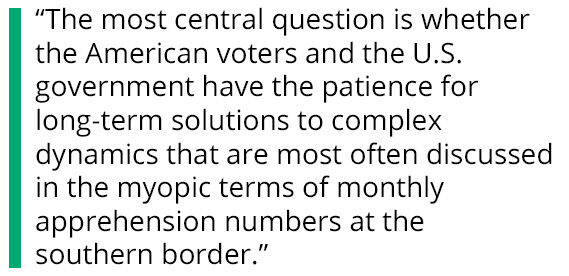 Fantini-Porter says that more than $650 million of the pledged $4.2 billion in investments has “hit the ground in the last 20 months.” The metrics also show, according to Fantini-Porter, that approximately 450,000 people have been brought into banking systems for the first time, and 4 million individuals have gained internet access.
Fantini-Porter says that more than $650 million of the pledged $4.2 billion in investments has “hit the ground in the last 20 months.” The metrics also show, according to Fantini-Porter, that approximately 450,000 people have been brought into banking systems for the first time, and 4 million individuals have gained internet access.
“We capture these measurements to ensure that there’s accountability in the long run. And then with Harvard, we evaluate how those data points are impacting the region.”
No matter how vigorously all of the ideas laid out in the Root Causes Strategy are pursued, there will remain inherent limits on how much the U.S. can affect regional forces on migration throughout the Americas. While policies can be put in place to try to address “push” factors such as substandard wages and violence in the home, “pull” factors are nearly impossible to influence. “One thing that sets Central American countries apart from almost every other country,” says Rooney, “is the existence inside the United States of very large Central American communities. It’s probably not an exaggeration to say that every Salvadoran, every Central American knows at least one person — in most cases, a family member — who’s living in the United States. We have to be realistic about that. You very quickly get to [pull] issues that are simply not within the grasp of the United States to change.”
Rooney also wonders about the sustainability of the investments that have been made over the last two years through Vice President Harris’s Call to Action. Many of them are tied to a certain degree of matching taxpayer funds. “The administration is using facilities like the Development Finance Corporation [DFC] to put U.S. government money alongside these private investors’ money. My question is, what happens when that DFC fund is exhausted? Is that investment going to remain?”
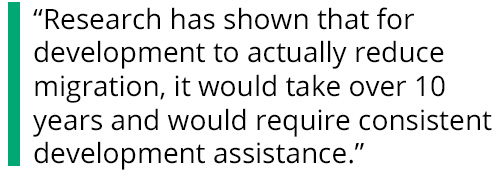 Sustainability will be essential, as the Root Causes Strategy is a long-term vision. Perhaps the most central question is whether the American voters and the U.S. government have the patience for long-term solutions to complex dynamics that are most often discussed in the myopic terms of monthly apprehension numbers at the southern border.
Sustainability will be essential, as the Root Causes Strategy is a long-term vision. Perhaps the most central question is whether the American voters and the U.S. government have the patience for long-term solutions to complex dynamics that are most often discussed in the myopic terms of monthly apprehension numbers at the southern border.
“Research has shown that for development to actually reduce migration,” says Ruiz Soto, “it would take over 10 years and would require consistent development assistance. The intention from the Biden administration, I think, is the right direction. But there is no silver bullet to reduce migration.”
Ruiz Soto emphasizes the importance of thinking about migration as a global issue, rather than a domestic one. “Working collaboratively with other countries — and I really mean beyond Central America — is a much better, longer lasting approach, even if it doesn’t produce immediate results, especially when Congress on both sides of the aisle wants immediate fixes. That’s been the Achilles heel of U.S. immigration policy for decades: trying to solve irregular immigration at the border when the underlying conditions are much more entrenched and will take decades to fix with consistent effort from the U.S. and other countries. Until we get there, we’re going to continue to see that big migration numbers from one country are going to shift to another. I think there are some people in the White House who know this, but they’re trying to figure out where policy meets politics.”
Read More:
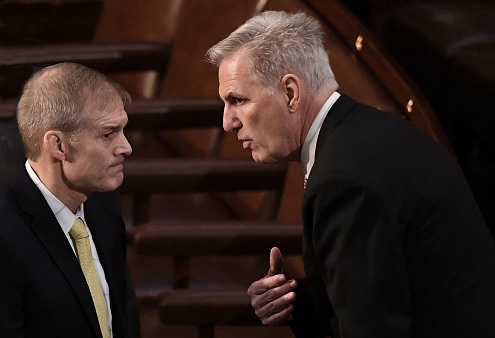

Capitol Hill Briefing No. 4
